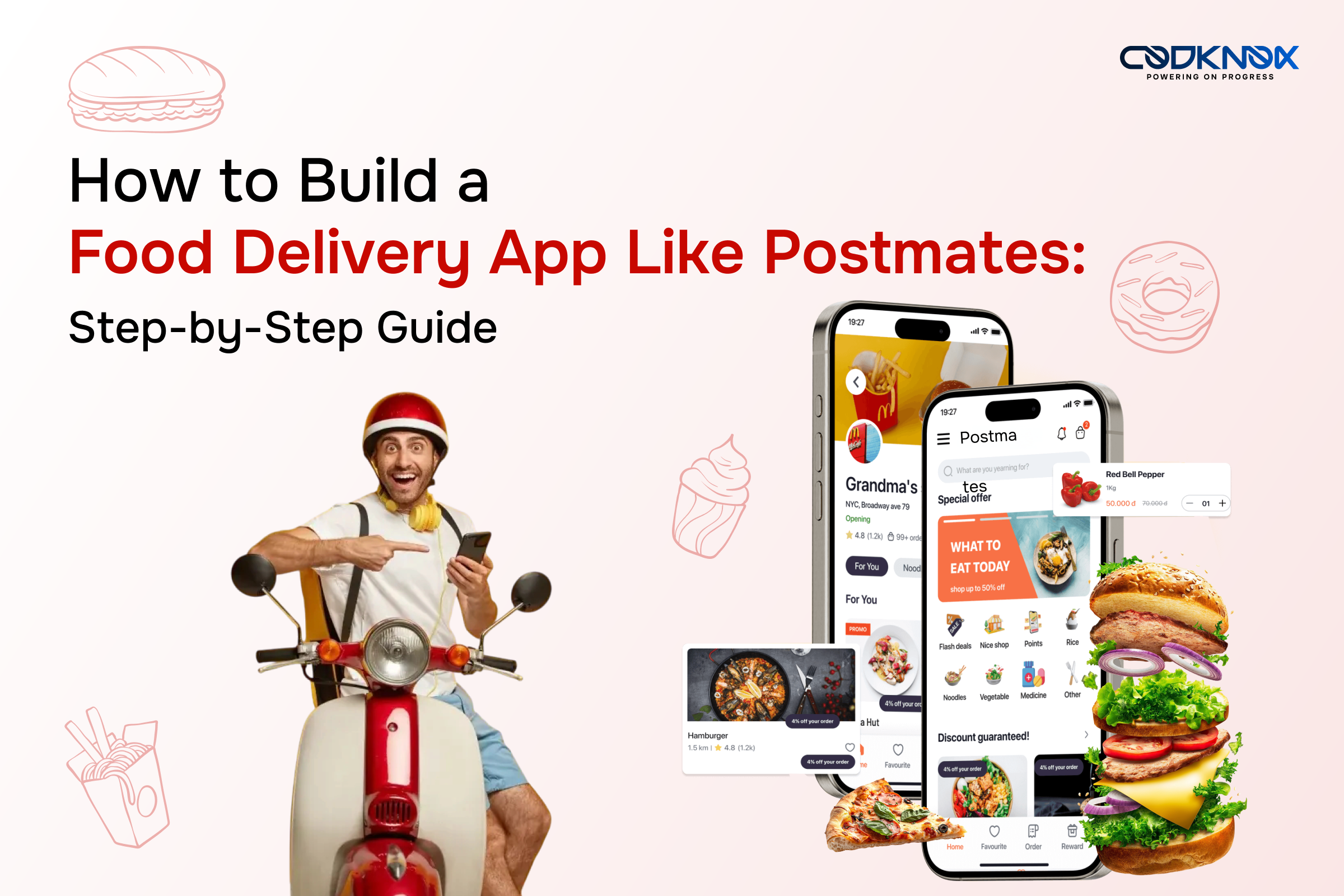Food delivery has become a new normal, especially after the pandemic, and there is strong data to back it up. As per Statista, the total number of users in the food delivery industry is expected to reach 2.5 billion by 2027. Various apps are popular among consumers, like Postmates, Grubhub, and Uber Eats. Postmates is undoubtedly one of the admired apps among the US audiences, probably one of the prime reasons why Uber acquired it in 2020.
Any business that wishes to invest in a food delivery app should consider the Postmates model as an inspiration and a great one to follow. Food delivery app development may seem tiring and complicated, but once you get an idea of the development process and partner up with an expert development company, the process becomes easier to follow.
Through this blog, we explore important features, cost, and development steps of a food delivery mobile app.
Postmates Statistics and Facts
- Postmates has over 9.3 million active monthly users who order 5 million items a month.
- Postmates generated $730 million in 2021, a 14% increase year over year.
- Postmates operates in over 3,000 cities in the USA.
- A subsidiary of Uber Eats, Postmates operates in the US and accounts for 23% of the company’s total revenue with a 2% market share.
What is Postmates?
Postmates is a popular on-demand delivery mobile application that permits users to order anything from local grocery stores, retail shops, or restaurants and have it delivered directly to their doorstep. The app was launched in 2011 in San Francisco and acquired by Uber in 2020. If you are planning to create an app like Postmates, first, you need to know about the important features and development process.
Key Features of a Food Delivery App like Postmates
A food delivery app like Postmates has features that are important for functionality, like any other delivery app. Although certain features are a must-have, such as user login, secure payment gateway, real-time order tracking, etc. Below, we have mentioned a list of different apps.
Customer App Features
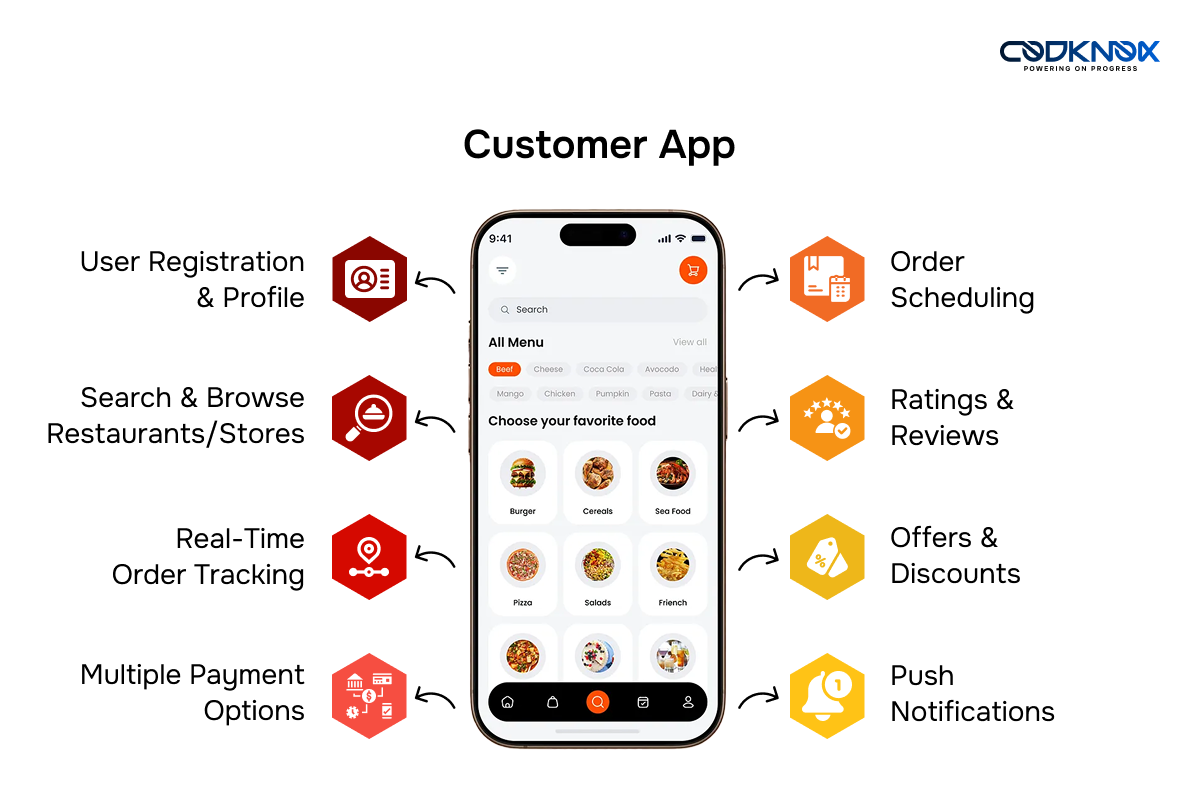
- User Registration & Profile: This feature makes it simple for users to register and log in.
- Search & Browse Restaurants/Stores: This function makes it simple for customers to look through the menu or merchandise of a restaurant or store.
- Real-time order tracking: Provide transparent real-time updates from order confirmation to delivery.
- Several Payment Options: For user convenience, there are several safe ways to pay, including wallets, UPI, cards, and cash-on-delivery (COD).
- Order Scheduling: This function allows customers to reserve meals or necessities in advance for delivery at a time of their choosing.
- Ratings & Reviews: Clients can provide candid comments regarding the cuisine they ordered and the delivery staff.
- Offers & Discounts: Customers can simultaneously view offers and discounts from several establishments.
- Push Notifications: Users receive notifications about the status of their deliveries, new deals, and app updates.
Driver App Features
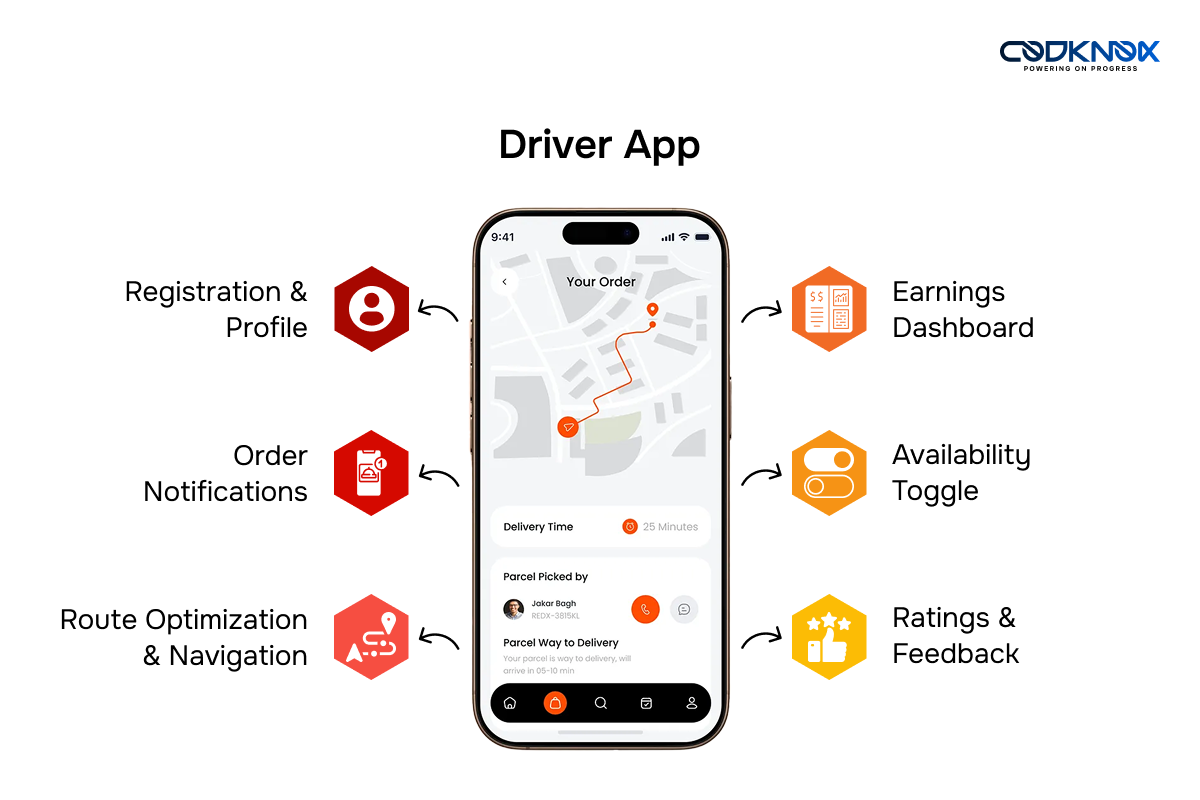
- Registration & Profile: Drivers get to create and manage their profiles effortlessly.
- Order Notifications: Drivers get instant notification regarding new order requests and customers’ instructions.
- Route Optimization & Navigation: Accurate maps and optimized routes to ensure rapid food delivery.
- Earnings Dashboard: Delivery person gets detailed insight into their daily earnings, payouts, and completed orders.
- Availability Toggle: This feature allows drivers to show their availability status.
- Ratings & Feedback: With the help of this feature, drivers can see customer feedback and ratings.
Restaurant/Store App Features
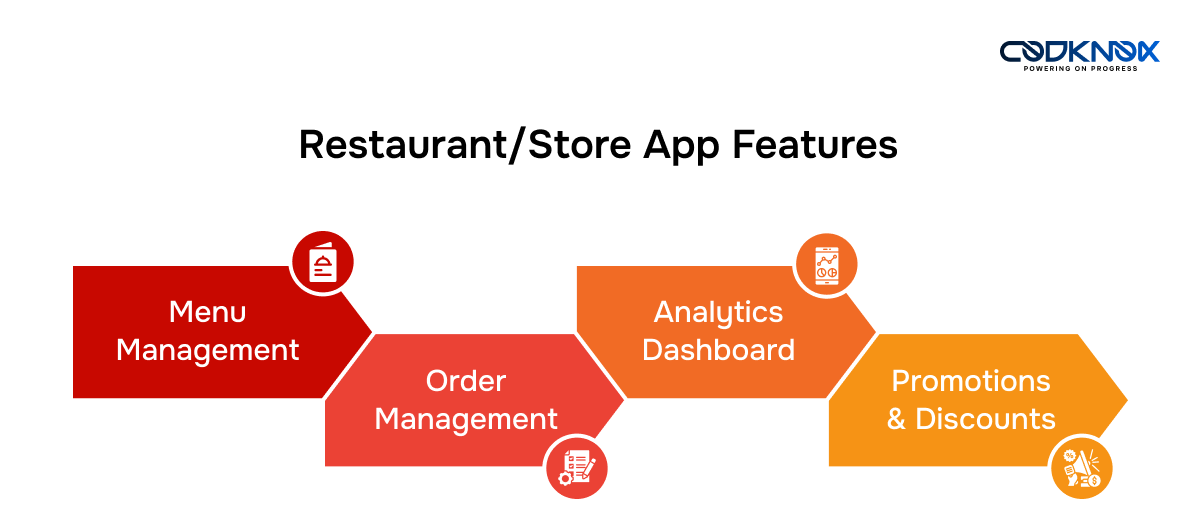
- Menu Management: Restaurants can add new menu items, remove an item, or manage pricing.
- Order Management: Helps to simplify the process of tracking, receiving, and fulfilling consumer orders.
- Analytics Dashboard: Offers insight into sales, consumer preferences, and trends to execute data-driven decisions.
- Promotions & Discounts: This feature allows you to share offers and discounts.
Admin Panel Features
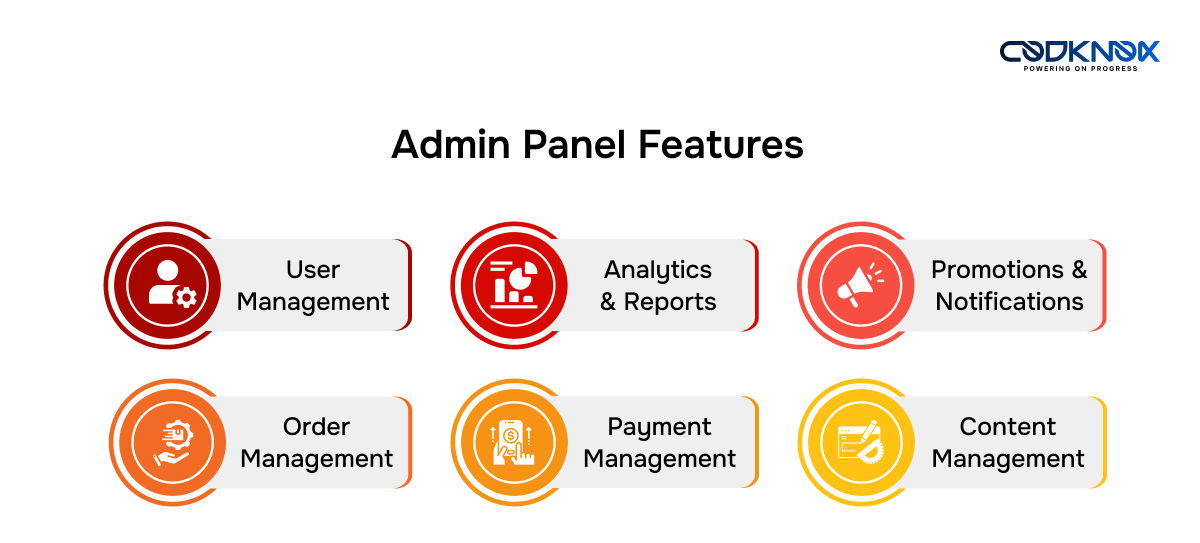
- User Management: Helps the admin manage users and drivers. Helps the admin manage users and drivers. With this, the admin can monitor user activity, verify accounts, manage complaints, etc.
- Order Management: This feature gives the admin complete control over the orders, whether incoming or completed orders.
- Analytics & Reports: Ensure to add this feature in the food delivery app development as this tool offers an insight into the app’s performance, such as sales trends, favored dishes, etc.
- Payment Management: Payment management permits the admin to track payments, all transactions, manage funds, etc.
- Promotions & Notifications: Admin can showcase offers, send notifications to customers, and promote marketing campaigns.
- Content Management: It allows updating app content, adding or removing any content, and ensures that the app looks appealing.
How to Make an App like Postmates
Following, we have mentioned significant steps that must be taken before and during app development;
-
Research the Market
Before launching your food delivery app, learn about the market, rivals, their strategies, statistics, and the entire process. Recognize customer needs, identify gaps in the offerings of your rivals, and attempt to fill those gaps with your app. Determine the goal of your on-demand delivery apps. For assistance in configuring your on-demand delivery app, speak with a mobile app development business.
-
Choose a Business Model and Revenue Model
There are numerous apps for food delivery, including Postmates. After examining their income and business methods, decide which app is best for starting an on-demand meal delivery service. Recognize the revenue and business models that your competitors in the market are using.
-
Finalize App Features
You must concentrate on the app’s core while creating a food delivery service similar to Postmates: Finalization of features. Start with the area for user registration and profiles. Users should be able to register through the application, and the profiles section should display all of their personal information.
The second essential feature for the on-demand food delivery app is a restaurant listing. Ratings, addresses, menus, prices, and other relevant information should be included when listing restaurants. Provide clients and delivery partners with real-time GPS tracking. For a smooth order checkout process, incorporate an in-app payment system into your on-demand food delivery app, such as Postmates.
-
UI/UX Design
Another important development step in the process is the selection and completion of UI and UX design. Avoid using complex design features that could make your Postmates clone app take longer to load. For a flawless user experience, keep the application’s design simple throughout.
-
Begin the Development Process
Choose the tech stack for the food delivery app after the app flow is complete. To choose a tech stack, consult with a mobile app development business. You can use Flutter for cross-platform app development or React Native for frontend development. In the meantime, more than just a programming language is required for the backend. Database, cloud services, third-party API connectivity, and more.
-
Partners Management
Managing restaurants and delivery partners is just as crucial as managing customers. If you want dependable partner services with restaurants, make sure your application is simple for them to use and keeps up to date. To ensure on-time delivery, include live GPS monitoring in the delivery partners’ app as well.
-
Testing and Deployment
Test your food delivery app using a variety of techniques, such as user, security, performance, and functional testing. Before deployment, identify and fix any flaws, then launch the app with the assistance of a reputable mobile app development firm.
-
Launch and Marketing
It’s time to launch the application after a successful deployment. Use a variety of marketing techniques to generate awareness prior to the launch date if you want your application launch to be successful. To reach a larger consumer base, food delivery apps must have effective pre- and post-launch marketing tactics.
To sum up, creating an on-demand food delivery company requires careful planning, the appropriate technology, and a strong user experience. Every step in this situation is critical to the success of the mobile app, including establishing the primary features, guaranteeing order processing, handling multiple payment methods, and so on.
Food Delivery App Development Cost
The cost of developing an app depends widely on numerous factors, such as the app’s complexity level, features, design quality, team strength, technology stack used, and the location of the development team.
However, the cost of a food delivery app like Postmates can range between $15,000 – $49,000 or more for a fully developed and customized app with advanced features. We have divided the category into three components, see the table below;

Want to Build a Postmates Clone App – Partner with CodKnox
Features and the development process are the two most significant things one must know to develop an app. Now that you know how much the food delivery app development can cost, it’s time to take the next step. To carry forward with the process, you need to join hands with a food delivery app development company in New York, USA, like CodKnox.
It is worth mentioning that the development of an app is a thorough process that needs strategic planning. You should hire dedicated app developers who are focused on developing innovative and high-performing solutions. You can trust CodKnox. We are a team of highly skilled experts who can guide you throughout the development process and construct an app that meets your requirements to the fullest. To know more, contact our team to book a 15-minute free consultation session.
Frequently Asked Questions (FAQs)
Q1. How long does it take to develop an app like Postmates?
The development time period of an app relies on the features, the app’s complexity level, the technology stack being used, the skills of the development team, and much more. However, on average, the total development time can range between 5 and 6 months.
Q2. What technology stack is best for developing a food delivery app like Postmates?
The tech stack depends on a project’s goals, but some of the commonly used technologies include Flutter or React Native for cross-app development and Python or Node.js for backend.
Q3. How do apps like Postmates generate revenue?
Food delivery apps such as Postmates earn money through delivery fees, commission from partner restaurants, in-app advertising, and surge pricing during peak hours.
Q4. Can a Postmates clone app be customized to fit specific business needs?
Indeed, a Postmates clone app may be customized to meet the needs of any business model by adding distinctive branding, features, and functionality, including local delivery integrations, regional payment gateways, and loyalty programs.
